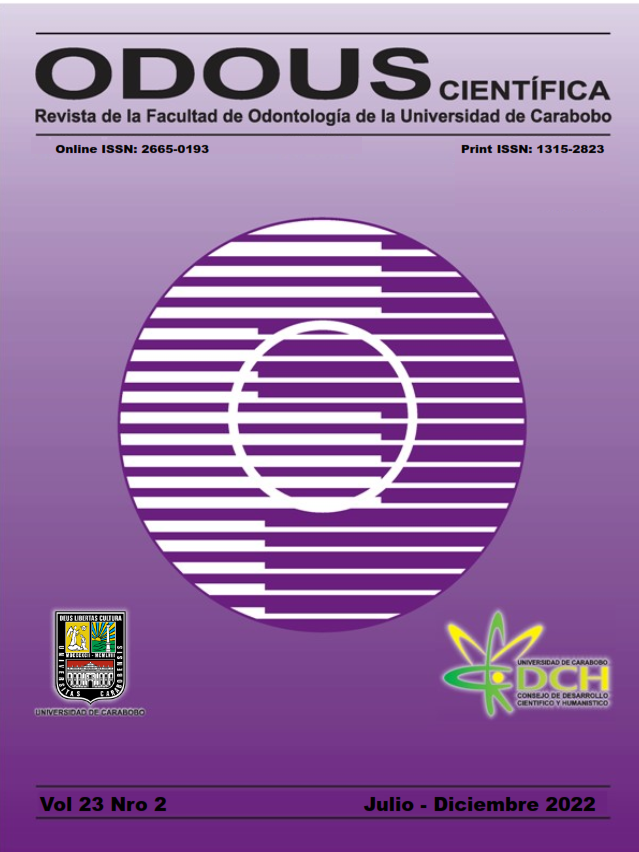Recurrent melanocytic nevus intradermal lipomized lip. Case report
DOI:
https://doi.org/10.54139/odousuc.v23i2.534Keywords:
recurrent melanocytic nevus, lipomyze, intradermalAbstract
Pigmented skin lesions are the most frequent, becoming the common reason for consultation in dermatology, with nevus being the pigmented lesion with the highest incidence. Nevus is classified by the WHO as a benign neoplasm of melanocytes that affects skin and mucous membranes with the capacity for malignant transformation, both pigmentary and non-pigmentary; It can appear in the oral cavity so the dentist must know and familiarize himself with this type of injury. The importance of nevus lies in the ability it has to undergo malignant transformation, so it is recommended that these pathologies be evaluated when presenting changes in color, size, contour, surface, asymmetry or before the appearance of pruritus, bleeding, pain, etc. A case of recurrent lipomized intradermic melanocytic nevus of the upper lip in a 66-year-old female patient with oncological history is exposed, it evidenced changes in its coloration, contour and surface, as well as the appearance of pruritic sensation; Given what was described, a complete surgical exceresis and histological study were performed, resulting in proliferative characteristics (proliferation of melanocytes) together with degenerative changes (mature fat cells), affirming the need for evaluation and treatment of any pigmentary lesion that presents clinical changes accompanied or not by symptoms.
Downloads
References
Aguilar N. Nevus melanocítico de la infancia. Anales españoles de pediatría 2001;54(5):477-83
Bolognia J et al. Drmatología Madrid. Editorial Mosby 2004: 1709-13.
Alcalá D, Valente I. Nevus melanocítico y no melanicítico. Revisión de la literatura Rev Cent dermatol Pascua;19(2):49-58.
Garrido M. Comparación del perfil de expresión proteico entre nevus y melanoma. EPrintsComplutense. Repositorio institucional de la UCM. 2010. Tesis doctoral disponible en [https://eprints.ucm.es/id/eprint/10719/]
Vidal D, Valenzuela N, Pimentel L, Puig L. Nevus melanocítico. Clinica y tratamiento. Farmacia profesional 2001;85-90
Garnacho G, Moreno J. Trastornos de la pigmentación: léntigos, nevus y melanoma. Fotoprotección. Pediatr Integral 2016;XX(4):262-73
Mordoh A. Genética de los nevos melanocíticos adquiridos y congénitos. Dermatología argentina 2019;25(3):97-113.
Kabir S, Payal C, Khushbu G. Optimal management of common acquired melanocytic nevi (moles): cent perspecyives. Clin Cosmet Investig Dermatol. 2014:7;89-103
Martín J, Rubio M, Bella R, Jordá E, Monteagudo C. Regresión completa de nevos melanocítico: correlación clínica, dermatoscópica e histológica de una serie de 13 casos. Actas DermoSifiliográficas;103(5);401-10.
Mateu T, Vilavella C. Ques es la dermatoscopia y como funciona. AMF 201713(10;543-346
Zaballos P, Carrera C, Puig S, Malvehy J. Criterios dermatoscópicos para el diagnóstico del melanoma. Med Cutan Iber Lat Am. 2004;32(1):3-17
Vena G, Fargnoli M, Cassano N, Argenziano G. Drug-induced eruptive melanocytic nevi. Expert Opin Drug Metab Toxicol. 2017;13(3):293-300.
Pedrini F, Cohen E. Cabo H. Dermatoscopia de lesiones melanocíticas: nevo recurrente. Dermatol Argent. 2012;18(3):245-46
Leofont J. Nevus recidivante. Rev Argent Dermatol.1986;67(3):171-3.
Vourh M, Martín L, Barbarot S. Large congenital melanocytic nevi: Therapeutic manggement and melanoma risk: A systematic review. J Am Acad Dermatol 2013;68: 293-8.
Nagore E, Guillen C. Botella R. Requena C, Serra C, Martorell A, et al. Clinical and epidemiology profile of melanoma patients according to sun exposure of the tumor site. Actas Dermosifiliográficas 2009;100(3):205-11.
Argona C, Gil C, Jiménez D, Albarran C. Melanoma intradérmico asociado a nevo melanocítico intradérmico. Actas Dermasifiliográficas 2015;106 (9):776-7.
Tai F, Pereira V, Babak S, Radovanic I, Sade S, Teshima T. Malignant melanoma within a cellular blue nevi presenting as a vascular malformation and the connection to sporadic KRAS mutations. Case Rep Dermatol 2021;13(2):310-6.
Navarro E, Marina M. El retorno del nevus. Semergen 2014;40(3):170-1.
Valdes F, Ginarte M, Toribio J. Melanocitosis dérmica. Actas Dermosifiliograficas 2001;92(9):378-88.
Natarajan E. Black and brown oro-facial mucocutaneus neoplasms. Head and Neck Pathol 2019,13(1)56-70.
Philip R. Zito P. Cutaneus melanoachantoma.2022. InStatPearls. StatPearlsPublishing
Cariglia S. Melanoacantosis bucal: Diagnóstico t tratamiento de un caso clínico.Revista ADM 2014;71(1):28-30.
Cardona M, González M, González J. Malformación hiperpigmentada en dorso de pie:melanoacantoma cutáneo. Dermatología CMQ 2016;14(2):168-70.
Hasbún P, Cullen R, Maturana C, Aves R, Porras N. Carcinoma basocelular pigmentado que simula un melanoma de extensión superficial. MedWave 2016;16(11):685.
Downloads
Published
How to Cite
Issue
Section
License
Copyright (c) 2022 ODOUS

This work is licensed under a Creative Commons Attribution-NonCommercial-NoDerivatives 4.0 International License.





